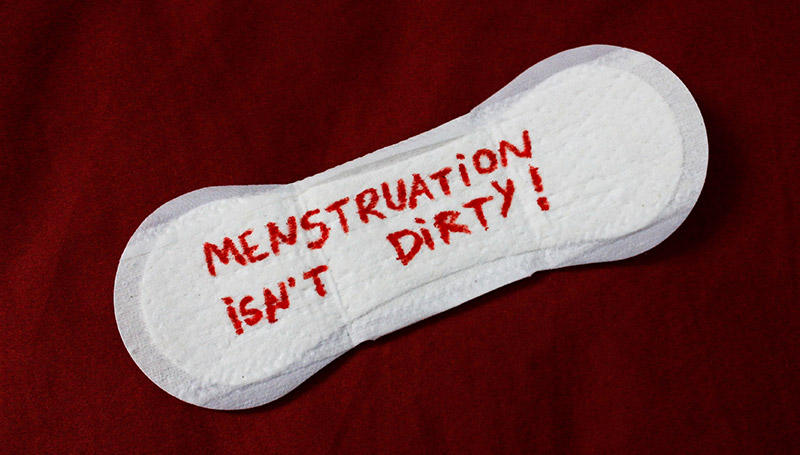We have all heard different euphemisms for a woman’s menstrual period:
Period. Menstruation. Aunty Flow. The Red Tide. Riding the crimson wave. The Red Scare. Girl Flu. Shark Week. The Red Baron. Code red. Bloody Mary. The blob. Lady business. Checking into the Red Roof Inn. Red wedding. Carrie. Monthly friend. Having the painters in. Moon time. Cranberry woman. The curse. Time of month. Strawberry week. On the rag. Crimson tide. Mother Nature. Riding the cotton pony. The red skeleton dropped by. Red moon. Granny’s stuck in Traffic. Bloody Mary. Ketchup week. Technical difficulties. Moon sickness. Crotch emissions. Red menace. Lady time. Down for maintenance. In need of medicinal chocolate. Paying for that apple. Underwear tie-dying. Serving box wine. Someone’s poisoned the waterhole.
There are differing ideas about when the prejudices against menstruation started.

Some people are of the opinion that it started with original sin: Eve succumbed to temptation and in so doing committed women to a distasteful method of reproduction. There is the opinion that in earlier man’s attempt to conquer nature and become master of his universe, he distanced himself from Mother Nature: she was the force against which he was fighting and the female’s identical attributes of nurturing and fertility were regarded with contempt.
This misunderstanding has stood the test of time and is still prevalent today.
We often look around and marvel at what our species has achieved yet certain old prejudices run deep. A quick google search will lead you to many pages containing dozens of euphemisms for menstruation because we’re led to believe the actual thing is too ugly and we must not talk about it. In one survey spanning 190 countries, they managed to compile a list of 5000 euphemisms and found that there are many that are culturally specific such as: “Mad Cow Disease” in Finland, and “There are Communists in the Funhouse” in Denmark. The issue crosses borders, cultures and languages.
A consequence of this prejudice is that many girls and women feel that their fertility is a burden and something to be shied away from. It is not something that is celebrated or that many people feel open to discuss but is a monthly event that needs to be tolerated…before it rears its ugly head again next month.
Men (and women) will take their cues form the important women in their lives: grandmothers, mothers, sisters, and aunts. In this way these attitudes will span cultures and generations.

Girls feel ashamed going to the store to purchase their menstrual products, their “monthly supplies”, and are often ashamed to be seen shovelling the products into their baskets, never mind actually pausing to read the boxes or look up what’s actually in them. And it’s not great news. Tampons are generally made from cotton, a crop that uses almost ⅓ of the world’s pesticides (in one study, 85% of the tested sample contained glyphosate). The process of dying the rayon in tampons with chlorine also results in the production of dioxins, another known carcinogen. Endocrine disruptors such as BPA are present in the plastics used.
Putting these chemicals in contact with the highly absorbent vaginal mucosa doesn’t seem like the best idea. Unfortunately, most sanitary pads also contain many of the same harmful chemicals. Another issue with tampons is that they are great at absorbing liquid. So good, in fact, that they dry out the vagina and interfere with the pH and normal flora that thrive in a moist environment throwing off natural defences against invading organisms. They also tend to shed fibres that stay in your vagina and, in the dry environment, they form a great place for bacteria to grow. Tampons also don’t do a good job of removing all of the tissue that the uterus expels, causing it to get ‘backed up’.
Hormonal Hijacking
Hijacking of the natural hormone cycle isn’t just affected by the endocrine disruptors in the menstrual products that we use but by what we ingest, including different methods of contraception. Whether they are used to prevent pregnancy, treat painful periods or to avoid a period when it’s inconvenient, they disrupt your body’s delicate hormonal balance. It’s also impossible to ignore the freefall that occurs when one of these interventions is stopped and the body has to attempt to re-establish balance.
An open conversation could go a long way to educate ourselves and others about better options when it comes to fertility. Some ladies have found great success with menstrual cups – they have a minimal effect on the vaginal environment and don’t contain toxic chemicals – which makes them a great option. Others opt for cloth pads or sponges without harmful chemicals that can be washed and reused. Organic tampons can be a slightly healthier option for women who aren’t comfortable with the other options, but they do still contain some harmful chemicals.
Let’s take the time to open communication and empower ourselves and each other.

For more information on fertility awareness and to source menstrual products that are less harmful to your lady bits, get in touch with Rona at Mindful Menstrual Cycles.
Find out more about Chiropractic and Women’s Health here.
Peak Chiropractic Centre located in Claremont are family-friendly chiropractors focused on relieving aches, pains and posture correction. We offer in-house X-Ray facilities.


